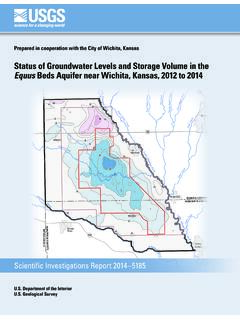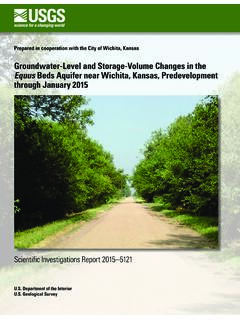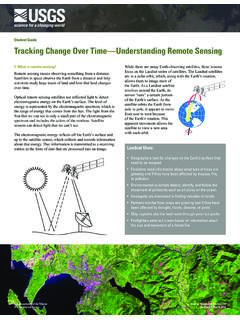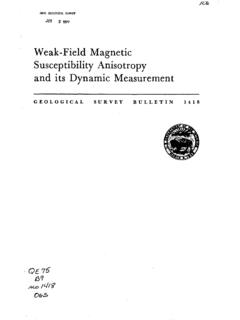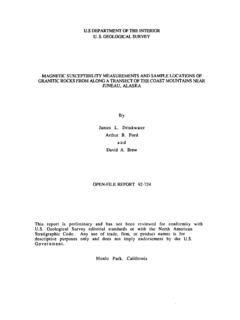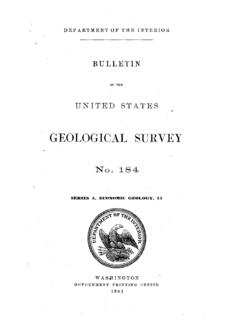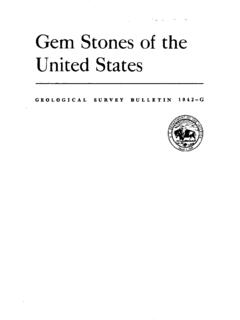Transcription of United States National Seismic Hazard Maps - USGS
1 Department of the Geological SurveyFact Sheet 2008 3017 April 2008 Printed on recycled paperUnited States National Seismic Hazard MapsThe Geological Survey s maps of earthquake shaking hazards provide information essential to creating and updat-ing the Seismic design provisions of building codes and insurance rates used in the United States . Periodic revisions of these maps incorporate the results of new research. Buildings, bridges, highways, and utilities built to meet modern Seismic design provisions are better able to withstand earthquakes, not only saving lives but also enabling critical activities to continue with less disruption. These maps can also help people assess the Hazard to their homes or places of work and can also inform insurance 2008 Geological Survey National Seismic Hazard Maps for the United States are based on current information about the rate at which earthquakes occur in different areas and on how far strong shaking extends from earthquake sources.
2 Colors on this particular map show the levels of horizontal shaking that have a 2-in-100 chance of being exceeded in a 50-year period. Shaking is expressed as a percentage of g (g is the acceleration of a falling object due to gravity). The National Seismic Hazard Maps are revised periodi-cally by the USGS to include new research results on earth-quake faults, crustal deformation, and earthquake ground shaking. The timing of the updates is designed to coincide with the schedule for updates of model building codes. During the update process, USGS solicits recommendations for improvements from the earth science and engineering communities, prepares draft maps that are vetted regionally, and solicits both public and expert opinion in review of the maps before they are finalized. Producing these maps is a key responsibility of the USGS in the four-agency, congressionally established National earthquake Hazards Reduction Program (NEHRP).
3 The NEHRP agencies work cooperatively with appropriate National building codes and standards organiza-tions to ensure that the most up to date and technically sound earthquake engineering design technology is available for use around the Nation. The four agencies Federal Emergency Management Agency (FEMA), National Institute of Standards and Technology (NIST), National Science Foundation (NSF), and USGS view the implementation of building codes as a central purpose of this partnership and the best means to ensure that buildings and other structures in local communities are adequately protected against natural s first line of defense against earthquakes is the construction of buildings that can withstand severe shaking. Cities and counties rely on the Seismic design provisions in building codes to ensure that structures can resist the earth-quakes that are probable in their region.
4 The variations in the Seismic threat across the country are depicted on maps in building codes as zones of different risk levels. These build-ing code maps are based on more detailed maps, collectively known as the National Seismic Hazard Maps, prepared by the Geological Survey (USGS) with input from scientists and engineers at universities, State geological surveys, and the private National Seismic Hazard Maps incorporate a wealth of geologic and seismologic information used to estimate the shaking, or ground motion, from earthquakes. In particular, the maps incorporate estimates of the magnitudes and locations of all likely earthquakes, how often these earthquakes occur, and the strength of ground shaking that they cause. The maps are time-independent, as they portray a long-term average Hazard and are not affected by the time of the last earthquake rupture.
5 This attribute makes the maps well suited for use in building codes, where the long-term life of a structure and its resilience to earthquake shaking must be g16-3232-4848-6464+8-164-80-4Hi ghest hazardLowes t hazardCharleston, South Carolina, earthquake August 31, 1886. The worst earthquake wreck in Charleston. (USGS photo library). Photograph by Hazard maps have many other applications. For example, the 2002 USGS National Seismic Hazard Maps are used as the basis of Seismic design requirements for highway bridges nationwide. Such maps are also used by:Insurance companies to set property rates in various areas of the Emergency Management Agency (FEMA) to plan the allocation of assistance funds for education and preparedness and improve risk and loss modeling companies to estimate potential losses to a region or to a portfolio of assets.
6 Civil engineers to estimate the stability and landslide potential of hillsides, and the liquefaction potential of strata underlying Environmental Protection Agency to set construc- tion standards that help ensure the safety of waste-disposal new series of National Seismic Hazard Maps was pub-licly released by the USGS in 2008. Each of these maps shows the severity of expected earthquake shaking for a particular level of probability. For example, the map on the front page shows levels of earthquake shaking that have a 2-in-100 chance of being exceeded in a 50-year period. The time period of 50 years is commonly used because it represents a typical building lifetime, while the 2-percent probability level is usually consid-ered an acceptable Hazard level for the building codes. This new series of maps also depicts shaking using a number of different measures that engineers can readily apply to designing earth-quake-resistant buildings of different heights, which respond to different frequencies of ground updated National Seismic Hazard Maps incorporate newly published Seismic , geologic, and geodetic models that define the best available science on earthquake rates and associ-ated ground shaking.
7 These ground-motion models show the decay in ground shaking with distance from the earthquake source (attenuation), and incorporate the effects of varying soil type and faulting style. The updated attenuation models incorporate many recent earthquake strong-motion records and generally result in lower estimates of ground shaking than previous models. New fault studies, geologic maps, reflection and refraction surveys, and geodetic strain rate models provide insights into earthquake sizes and recurrence rates for crustal and subduction sources. This information was discussed with working groups, State geological surveys, Federal agencies, and other earth-science experts from industry and academia in revising the input models. The new ground-motion and earth-quake source models result in similar or lower predicted ground motion across most of the United States compared to motion calculated in earlier versions of the Hazard the continuing process of refining estimates of the shaking and earthquake Hazard across the Nation and observ-ing successes and failures in building design, scientists and There is no single mandatory National building code or stan-dard for designing and constructing buildings and other structures in the United States .
8 Building codes are adopted and enforced by individual States and by local jurisdictions within the States . State or local building codes are usually based on a model building code or other voluntary consensus standards. State and local governments may either directly adopt the model code or adopt the code with amendments. Today, the model building code that is predominantly adopted in the United States is the Inter- National Building Code (IBC), promulgated by the International Code Council (ICC), a non-governmental organization. The ICC also promulgates other model codes that impact the building process, such as the International Residential Code (IRC). Some localities have also adopted the National Fire Protection Associa-tion (NFPA) 5000 Building Construction and safety IBC and its companion ICC documents form the basis of the building codes in 46 States and have been adopted by local governments within the remaining 4 States ; thus, State and local building codes adopted throughout the United States share a common origin.
9 As States and localities have based their codes upon the model codes, the performance of buildings constructed in accordance with the newer building codes has four-agency National earthquake Hazards Reduc-tion Program (NEHRP) supports the development of Seismic provisions in building codes by maintaining the quality of four documents that build on one another:engineers are laying the groundwork for communities to remain safer during future earthquakes. By improving the resilience to earthquake shaking of homes, office buildings, hospitals, highways, dams, and utilities, scientists and engineers also help to ensure that those communities are able to recover rapidly following a major the Model Building Codes: The Role of Seismic Hazard MapsImplementation:Built EnvironmentEnd Users:Homeowners,GovernmentAgencies, Builders,Architects,EngineersState and LocalBuilding Codes andEnforcementState and LocalGovernmentsNational ModelBuilding Codes,Standards andGuidelinesPrivate SectorEntities, ProfessionalSocietiesEarthquake HazardAssessmentsUSGSE arth Science Research NSF, USGS, StateGeological Surveys,Private SectorSeismic Design MapsUSGS, FEMANEHRPR ecommended Provisionsand Design GuidanceFEMAB asic EngineeringResearchNSFP roblem-FocusedEngineering ResearchNISTR esearchImplementationNEHRP Impact on the Built EnvironmentFlow chart of the Building Code Process.
10 USGS provides both basic research and Hazard information that is critical to development of Seismic provisions in building codes. USGS works with other NEHRP agencies (FEMA, NIST, NSF) to ensure the most up to date and technically sound earthquake engineering design technology is available for use around the Assoc. of State Hwy. Transportation OfficialsAmerican National Standards InstituteAmerican Society of Civil EngineersApplied Technology CouncilBuilding Officials and Code Administrators InternationalBuilding Seismic safety CouncilState Geological SurveysCalifornia earthquake AuthorityEnvironmental Protection AgencyFederal Emergency Management AgencyInternational Conference of Building OfficialsMid-America earthquake CenterNational Science FoundationNational Center for earthquake Engineering ResearchNational Institute of Standards and TechnologyNational Oceanic and Atmospheric AdministrationPacific earthquake Engineering Research CenterSouthern Building Code CongressSouthern California earthquake CenterStructural Engineers Association of CaliforniaWestern States Seismic Policy CouncilThe NEHRP Recommended Provision for Seismic
